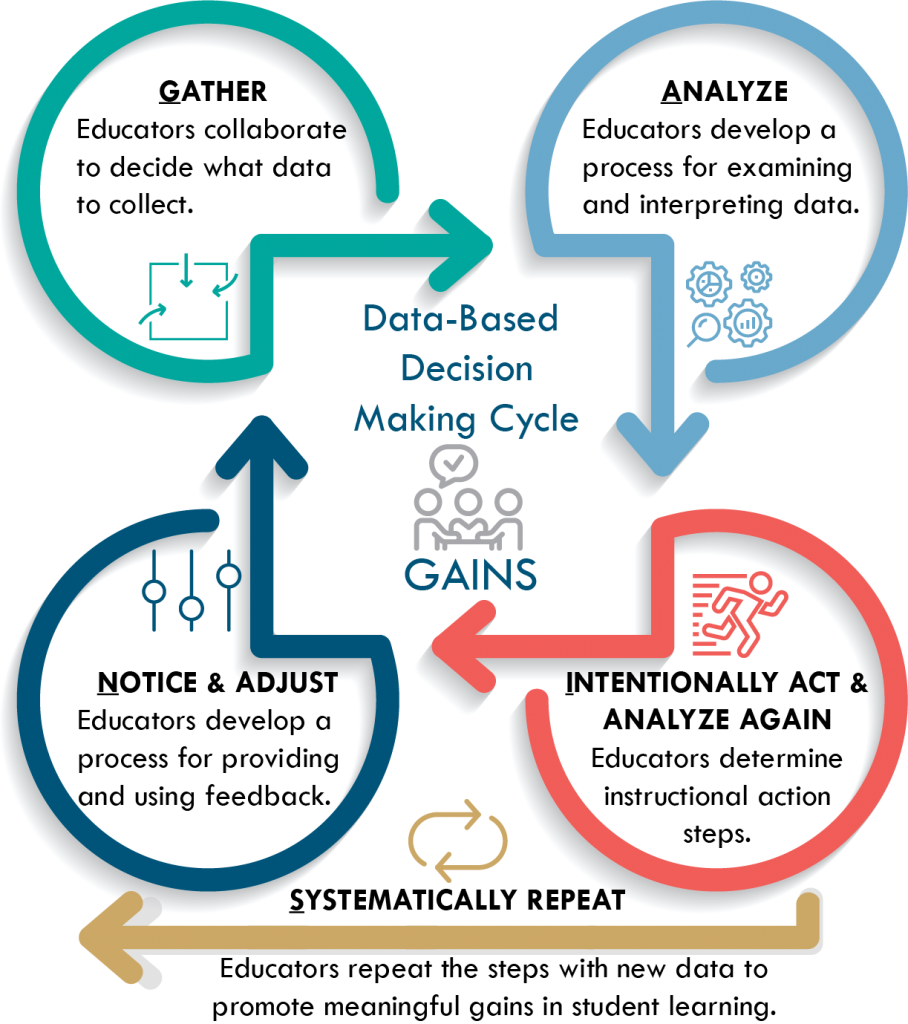“Whether you define your process as “change management” or use different nomenclature, every evolving organization understands the importance of consistently improving processes and overseeing changes that will yield lasting benefits.“
Achieveit., (n.d.)
UNPACKING ESSENTIAL FUNCTION 2: PATH SETTING
As a district moves toward a continuous improvement cycle, action planning becomes a cyclical process. Teams collect and analyze data which often can be used at multiple levels (district, building, and classroom) for different purposes. To ensure both communication and alignment occur at all levels, educational leaders must consider whether their current team structures and processes will support continuous improvement. At a minimum, districts will need a District Leadership Team, Building Leadership Teams, and at the classroom level Collaborative Teacher Teams.
In Missouri, the District Continuous Improvement Framework (MMD/DCI) includes three foundational educational practices essential for establishing a collaborative, data-driven teaching environment: Collaborative Teams (CT), Data-Based Decision Making (DBDM), and Common Formative Assessment (CFA).
The framework additionally addresses two evidence-based, effective teaching and learning practices shown to be highly effective in improving student achievement: Developing Assessment Capable Learners with Feedback (DACL) and Metacognition. To ensure fidelity and sustainability, three capacity building modules are also included: School-Based Implementation Coaching (SBIC), Collective Teacher Efficacy (CTE), and this module on Leadership.
The conceptual interconnectedness of the elements of the MMD/DCI Framework are important considerations for District and Building Leadership Teams. Together, these eight modules compose the MMD/DCI Framework for District Continuous Improvement. While implementation of selected components will most likely occur in phases, to ensure positive, system-wide outcomes leadership teams need to plan for the implementation of all components.
Setting a path for Continuous improvement: Action Planning using the G.A.I.N.S. process
A path to district continuous improvement must be data-informed in order to be effective. Educators involved in the MMD/DCI work utilize the G.A.I.N.S. process for data-based decision making (DBDM) to guide instructional decisions. This same process is used for data-based decision making when setting a path for district continuous improvement.
These are the key steps, guided by data and aligned with G.A.I.N.S., to set the path for continuous improvement.
- Gather district data sources that will help identify and prioritize areas needing improvement.
- Analyze district data, including the Mental Models Process (Zuieback, 2014) information, to identify problematic trends/ behaviors and to determine practices to be initiated or strengthened for high impact on student learning.
- Intentionally act by clearly defining the change needed, identifying and communicating a vision for outcomes, and developing and implementing an action plan.
- Notice and adjust by monitoring the effectiveness of the plan and making changes as needed.
- Systematically repeat the process
We will take a more in-depth look at each step in the next topic.
Reflection Questions
- How would you describe the data collection policies and procedures that are currently being used in your district?
- Is data collection a system-wide process within your district?
- Are the current practices and procedures supporting system-wide impact on learning?
Coaching Companion
Online Article: How can we ensure our KPIs are aligned to the strategy?Mihailoaie, C. (2019, April 22).
Online Article: How to improve employee buy-in (4 proven methods). Kothari, A. (n.d.).


